Throne and Liberty PvP Tournaments: Events, Formats, Rewards & More
Updated On: October 23, 2025 by Aaron Connolly
Throne and Liberty PvP Tournament Overview
Throne and Liberty PvP tournaments pull guilds from all over different servers, throwing them into organized battles for prizes and a bit of glory. You’ll see formats like guild-versus-guild warfare and elimination brackets, each with their own entry rules.
Types of PvP Tournaments
Guild vs Guild Tournaments really make up the heart of Throne and Liberty’s competitive scene. Whole guilds clash in massive battles, and it gets wild.
The War Games tournaments have become the main event. Organizers set up elimination brackets, and in the last big EU event, more than 50 guilds joined in.
Prize pool tournaments up the stakes, sometimes putting £3,000 or more on the line. When the rewards get that high, only the strongest guilds show up from across servers.
Regional competitions split up players by where they’re from. EU and NA regions usually run their own tournaments because of server setup and time zones.
Some tournaments start out server-based, letting guilds prove themselves at home before moving up to cross-server fights.
Tournament Structure and Formats
Most tournaments stick to elimination brackets. Guilds face off in either single or double elimination, depending on how many teams sign up.
War Games mode is the go-to for competitive play. Guilds fight under standardized rules and conditions, so there’s no funny business.
Big tournaments break down into several rounds. Typically, you’ll see:
- Round 1: Early elimination matches
- Semi-finals: The top guilds push forward
- Finals: The last two go head-to-head for the prize
Alliance restrictions pop up sometimes. Some tournaments let you fill empty spots with alliance members if your roster’s short.
Organizers set match schedules ahead of time. They juggle time zones so everyone gets a fair shot at showing up.
Eligibility and Participation Requirements
Guilds have to fill out detailed forms to register. Organizers want info like your guild’s size, server, and any alliances.
Tournaments require a minimum number of active members. If your guild can’t field enough players, you’re probably out.
Some events only let certain servers join, while others open the doors to anyone, regardless of where they play.
Guilds need to declare their alliances during registration. This helps organizers keep matchmaking fair and above board.
Registration usually closes a few days before things kick off. If you’re late, your guild probably won’t make the bracket.
Schedule and Event Calendar
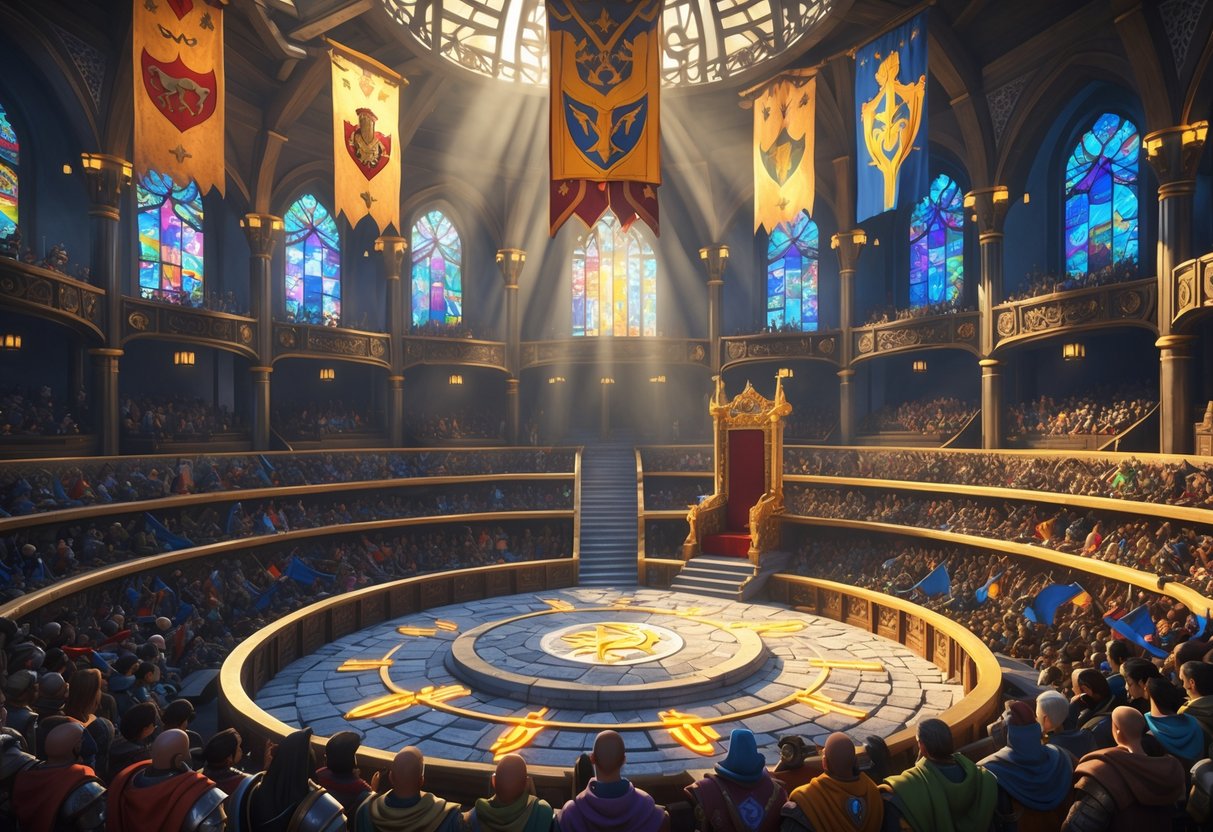
Tournament schedules in Throne and Liberty jump around depending on your server region. You’ll want to check both in-game notifications and community calendars every day so you don’t miss out.
Finding Upcoming Tournaments
Most PvP tournaments run on set cycles every few hours. On EU servers, major events usually start around 6pm and can go until midnight.
Dynamic conflict events keep competitive PvP interesting. These tournaments kick off every three hours and bring structured battles to specific zones.
Key Tournament Types:
- Guild Raids – Weekly archboss battles
- Conflict Events – Regular PvP zones with leaderboards
- Seasonal Championships – Monthly special events
You’ll need to register for tournaments at least 30 minutes before they start. Late entries just don’t make it in, especially for ranked events.
Community calendars like Games Lantern and questlog.gg do a better job tracking events than the in-game one, honestly.
Server and Region Differences
Tournament times shift a lot between regions. EU servers run most events between 6pm and midnight, but other regions do their own thing.
Each server has its own activity windows for different zones. If you don’t check your server’s schedule, you might miss out.
Regional Schedule Patterns:
- EU Servers – Evenings (6pm-12am)
- NA Servers – More spread out for different time zones
- Asia-Pacific – Totally different peak hours
Archboss events sometimes start earlier than regular PvP tournaments. You’ll catch those in the afternoon, no matter the region.
Busy servers run more frequent tournaments. So if your server’s packed, expect more action.
Using the In-Game Calendar and Notifications
The in-game event calendar lists all active tournaments. Just open the main menu and look for the event section to see what’s live.
Fifteen minutes before a tournament starts, you’ll get a notification. These alerts tell you where to go and what you need to join.
Calendar Features:
- Live Event Status – Shows what’s happening now
- Registration Timers – Countdown to sign-up deadlines
- Zone Markers – Quick navigation to the right spot
You can filter the calendar to show only PvP tournaments, which clears out the PvE clutter.
If you turn on push notifications for conflict events, you won’t miss a tournament. But honestly, leave them off for field bosses unless you like spam.
Arena Tournaments
Arena tournaments in Throne and Liberty bring structured, ranked PvP and seasonal events. The Arena system mixes competitive ranked play with casual modes, and you get rewards based on how well (and how much) you play.
Ranked Arena Matches
Arena runs on a seasonal ranking system, with inter-server matchmaking. Players fight in 3v3 format matches called “Free versus Free Arena,” and it’s always teams of three.
Ranking Structure:
- Pre-season events test the waters regularly
- Full seasonal rankings with competitive ladder
- Inter-server matching means you’ll face a bigger pool of opponents
- Rewards and progress reset every week
Access the Arena anytime from the main menu. The game matches teams by skill rating so fights stay fair.
To climb the ranks, you need to play consistently. Players who skip weeks fall behind, no way around it.
Normal and Friendly Arena Modes
If you want a break from ranked, the Arena has casual modes for practice and fun. Here, you can try new tactics without risking your rank.
Available Modes:
- Practice Arena: Test builds and team setups
- Custom Lobbies: Set your own match rules
- War Games: Guild vs guild tournaments
- Special Events: Limited-time modes with unique rewards
Normal modes stick to 3v3 but matchmaking is more relaxed. You can team up with friends or guildmates and just jump in.
War Games mode lets big guild tournaments happen, like those recent events with over 50 guilds. The prizes and community recognition aren’t bad either.
Arena Rewards and Progression
Arena gives out rewards for weekly performance and seasonal ranking. The system really encourages you to play regularly, not just aim for one big win.
Weekly Rewards:
- Arena Coins from each match
- Jewellery in the Arena shop for coins
- Trait Materials you can extract and sell for Lucent
- Titles as cosmetic achievements
You’ll need about 10 wins a week to unlock the best rewards. Arena coins buy useful trait items, and a lot of players just sell them for profit.
Progression Benefits:
- Higher skill rating means better matchmaking
- Seasonal titles show off your skills
- More store access as you play more
- Leaderboard spots bring some bragging rights
Arena is honestly one of the most reliable ways to earn tradeable stuff in the game. Some people are in it for the money, not the rankings.
Guild-Based Competitions
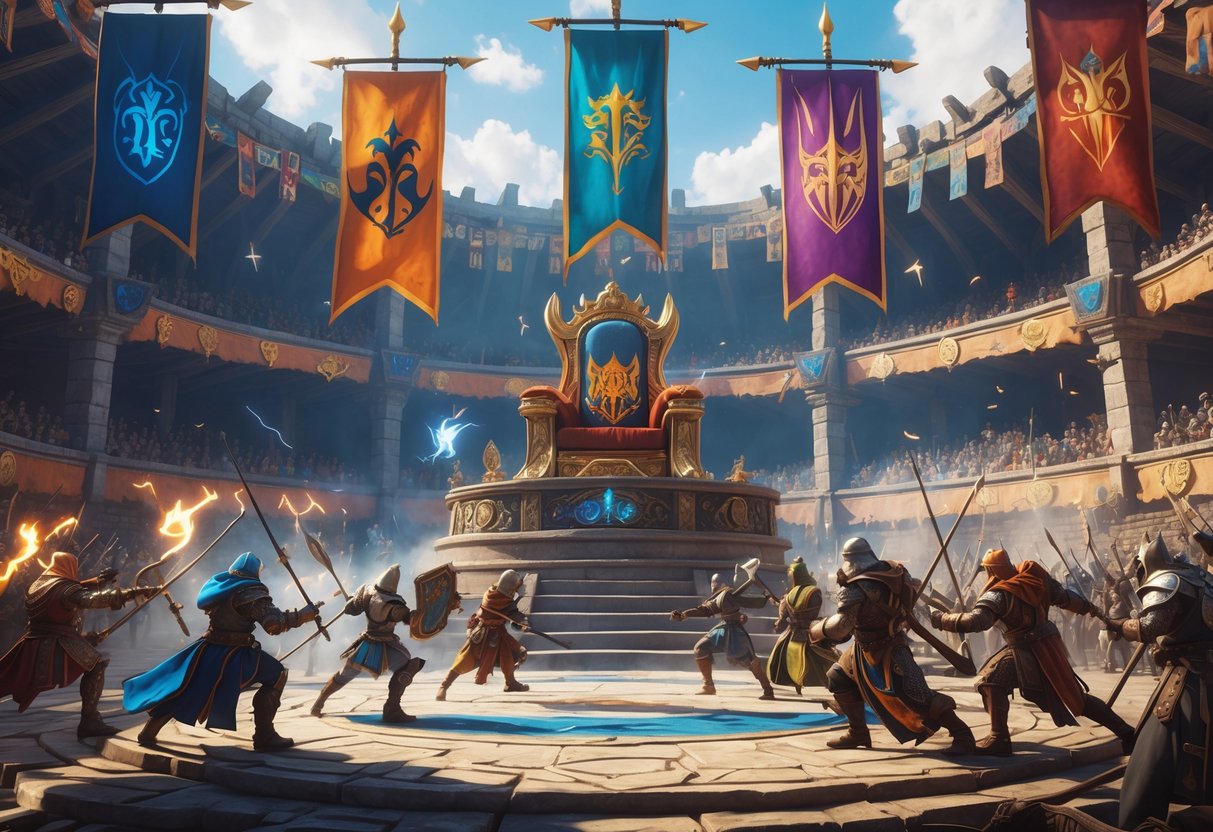
Guild tournaments stand as the top tier of organized PvP in Throne and Liberty. Prize pools can hit 1,300,000 Lucent, and these battles focus on teamwork and strategy to claim regional dominance.
Best in Guild Tournament
The Blue Squadron Best in Guild Tournament is the big one. It covers North America East, North America West, and Europe, and everyone wants the crown.
Tournament Format:
- Early rounds: 48 vs 48, single-elimination
- Finals: Best of three matches
- Prize pool: 1,300,000 Lucent
- Runs for several weeks
Each region picks one winning guild from a huge pool of competitors. NA West matches start at 6PM PT, NA East at 4PM PT, and EU at 10AM PT.
Viewing Rewards: Watch tournament streams on Twitch for two hours a week, and you’ll get Twitch Drops. Rewards include 200 Ornate Coins, 40 Precious Polished Crystals, 100 Battle Pass Star Crystals, and special titles like Squadron Commander.
Recent tournaments offered $2400 prize pools for regional winners.
Guild versus Guild Battles
Guild PvP is the real endgame here. These battles come in several forms, and each needs its own prep and strategy.
Core Guild PvP Events:
- Rift Stone Conquest: Huge territory fights
- Castle Sieges: The biggest battles, with siege engines and Golems
- Boonstone Wars: Fights over resources
- Open World Raid Bosses: PvP-enabled boss encounters
Castle Sieges get really complex. Defending and attacking guilds use Golems, Gigantrite, secret entry points, and special respawn spots. Whole alliances might join in.
Some dynamic events mix PvE and PvP. For example, mushroom gathering can turn into PvP if guilds cross paths, but sometimes it stays peaceful.
Team Composition Strategies
Winning guild competitions takes planning, especially in the 48v48 format. Every role counts, and coordination is everything.
Essential Roles:
- Front-line tanks to soak up damage
- Healers who keep everyone standing
- DPS for quick takedowns
- Supports for buffs and debuffs
Strategic Considerations: Guild leaders have to balance offense and defense. Communication tools become vital when dozens of players need to act together.
Preparation takes weeks of practice. Guilds work out different formations for attacking or defending, depending on the scenario.
Guild bases give everyone a spot to gear up and talk strategy before the big day.
Castle Siege Tournaments
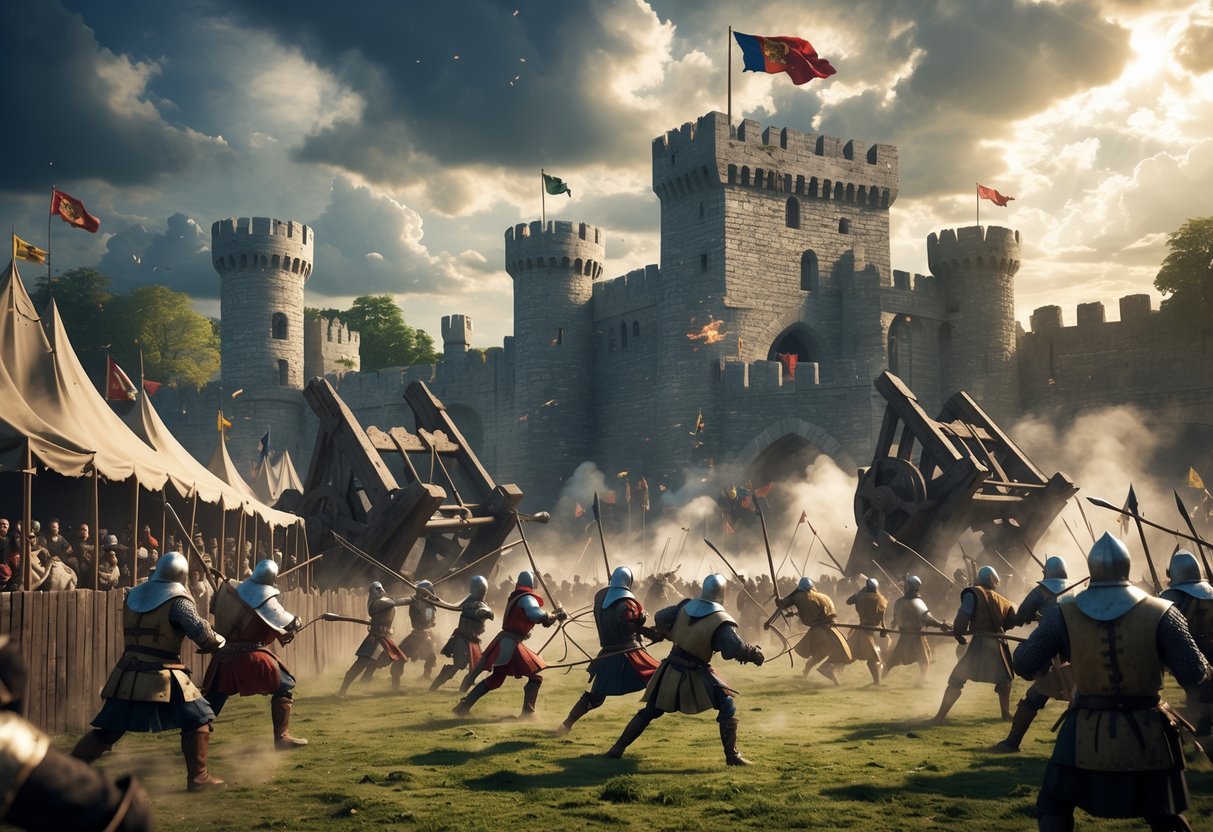
Castle siege tournaments throw guild alliances into massive 60-minute battles for Stonegard Castle. Attackers have to break through defenses and claim the throne, while defenders dig in and fight to hold their ground.
Siege Mechanics and Objectives
Castle siege tournaments center on capturing or defending Stonegard Castle through guild warfare. The event breaks into clear phases with unique mechanics.
Preparation Phase (15 minutes): Guilds use this time to finalize plans before PvP starts. Castle NPCs vanish, so buy what you need ahead of time.
Main Combat Phase (45 minutes): PvP kicks off at 21:15 server time. Defenders spawn inside the castle and can’t leave for five seconds. Attackers need to smash through several defensive layers to reach the throne room.
Key Siege Elements:
- Four Siege Golems: Stone Crasher, Battle Carrier, Gate Hammer, and Jump Attacker
- Siege Ruins: Four capture points for respawns and golem summoning
- Pillage Points: Five spots that generate rewards every five minutes
- Environmental Features: Sewage tunnels, gate levers, and secret entries
The throne room is the final goal. The attacking guild leader must reach the throne, transform into a Usurper, and survive three minutes in the capture zone with allies.
Scheduling Strategy
Castle siege tournaments stick to a set schedule, so guilds really have to plan ahead if they want the best turnout and a tactical edge.
Tournament Timing: Every two weeks, events kick off at 21:00 server time on chosen dates. They run for 63 minutes, including possible overtime.
Strategic Preparation Windows:
- One week before: Buy Golem Slates from the Guild Supplies Merchant.
- 24 hours before: Sort out alliance roles and decide who’s piloting which golem.
- Pre-event day: Stock up on consumables and make sure your gear’s repaired.
Optimal Guild Coordination:
- Have Guardian-rank players ready to capture Siege Ruins the moment PvP starts.
- Assign golem pilots ahead of time for all four siege engines.
- Rotate Pillage Point captures every five minutes to maximize rewards.
Alliance Management: Defending guilds get a five-second head start inside the castle. Meanwhile, attackers spawn closer to Siege Ruins, which gives them a natural advantage.
Try running practice sessions during off-peak hours. It’s a good way to iron out any issues with communication or coordination before the real thing.
Victory Conditions
Castle siege tournaments pick winners based on throne control and reward distribution, and there’s more than one way to come out ahead.
Primary Victory: If your guild holds the throne when the 60-minute timer runs out, you win the castle. But if multiple guilds are fighting for the throne at the end, the match goes into a three-minute overtime.
Overtime Rules: When the throne’s contested, the match extends. If attackers don’t take the throne before overtime ends, the defending alliance keeps control.
Alternative Rewards: You don’t actually have to win the whole siege to get something out of it. If your guild captures and holds Pillage Points, you’ll earn Lucent and Sollant from the Castle Tax Vault every five minutes.
Reward Structure:
- Castle Winners: Get 40% of the siege tax to split up.
- Pillage Point Holders: Steal currency from the vault depending on timing.
- Final Calculation: The reward splits 5:5 between Lucent and Sollant.
Critical Timing: Your guild only gets Pillage Point rewards if you control the point exactly at the five-minute marks (21:20, 21:25, 21:30, and so on). If you lose it right before, you miss out.
To capture the throne, guild leaders need to survive as Usurpers for three straight minutes. That makes defensive teamwork super important, whether you’re trying to take or keep the throne.
Boonstone and Riftstone Wars
Guild wars in Throne and Liberty revolve around fighting for control of special stones. These stones give your guild powerful buffs and resources.
Boonstones boost stats like critical hit and skill damage. Riftstones work in a similar way but hand out different rewards to the winners.
How Boonstones Work
Boonstones are basically “King of the Hill” objectives. Guilds fight over them every week. The guild leader or advisor needs to declare which boonstone to target 12-36 hours before the war.
Twelve hours before the war, the system picks two guilds for each boonstone battle. If the current owner’s the highest-ranked, they face the top challenger in a 1v1. Otherwise, the best challenger takes on the owner.
Guilds battle for 20 minutes to control the boonstone area. To capture it, you have to interact with the stone and hold your ground for a few minutes. Other guilds will try to break your defense and take over.
Available Boonstone Buffs:
- Talandre: +2 Dexterity, +50 Critical Hit
- Laslan: +50 Hit, +50 PvP Hit (Cross-Server eligible)
- Stoneguard: +50 Hit, +50 PvP Hit (Cross-Server eligible)
If guilds contest the boonstone right at the end, the match can go into overtime. Whoever controls the boonstone when time’s up keeps it for the week.
Riftstone War Structure
Riftstone wars play out like boonstone battles, but they’re fought over different spots on the map. Same King of the Hill format—guilds fight to control the central objective.
Guild leaders need to buy a Guild Flag from the Guild Supplies Shop to claim a riftstone. Once the fight starts, any guild can take the stone since it’s unprotected.
Winning a riftstone gives your guild buffs and hourly resources. Some riftstones even unlock big inter-server wars twice a month.
The selection process works just like boonstones. Guilds declare their intent, and the system picks who gets to fight based on rankings. If you hold the riftstone until the timer ends, you win.
Loot and Benefits for Winners
Guilds that win these wars get some pretty great rewards. Stat buffs from stones apply to everyone in the guild, so you’ll see a boost in both PvP and PvE.
Weekly Benefits Include:
- Ongoing stat bonuses (depends on the stone)
- Hourly resources for guild skills
- Access to cross-server tournaments (some stones only)
- Better guild reputation and ranking
Hourly resources fuel important Guild Skills for everyone. These skills can help with crafting, experience, or even combat.
Some boonstones and riftstones open up Inter-Server Wars—these are elite fights against top guilds from other servers. The first 48 guild members can enter through red portals that show up 10 minutes after a win.
Quick tip: Go for stones that boost skill damage first. They help the most if your guild has a mix of playstyles.
Open World PvP Tournaments
Open world PvP tournaments in Throne and Liberty don’t happen everywhere all the time. Instead, they rotate through certain zones during scheduled events.
These tournaments also include special night-time dungeons that only open under certain conditions.
PvP Zones and Timing
Open world PvP tournaments light up specific zones on a daily schedule. Each server posts a timetable showing when and where PvP will be active.
Zone activation happens two ways:
- Timed events – Certain zones turn on PvP at set times.
- Night cycles – Some areas automatically go PvP when it’s nighttime in-game.
Boss fight tournaments often run in these zones. Players can jump in or stick to PvE if they’d rather avoid the chaos.
The system gives us plenty of warning before PvP starts. You won’t get ambushed by surprise world combat outside of scheduled events.
Event Rotation and Night-Time Battles
Night brings special PvP chances with open world dungeons that only appear when the weather’s right. For example, the Sanctum of Desire dungeon opens only when it’s raining.
These events rotate, so different zones become active throughout the week. One day you might see excavator boss fights during daylight, and the next, dungeon raids after dark.
Night-time dungeon tournaments feature:
- Weather-based access (rain, storms)
- Guild vs guild fights for dungeon control
- Better loot compared to daytime events
The rotation keeps things interesting by changing locations and goals often. You can pick events that suit your style, whether you want big boss raids or smaller dungeon battles at night.
Dungeons as PvP Arenas
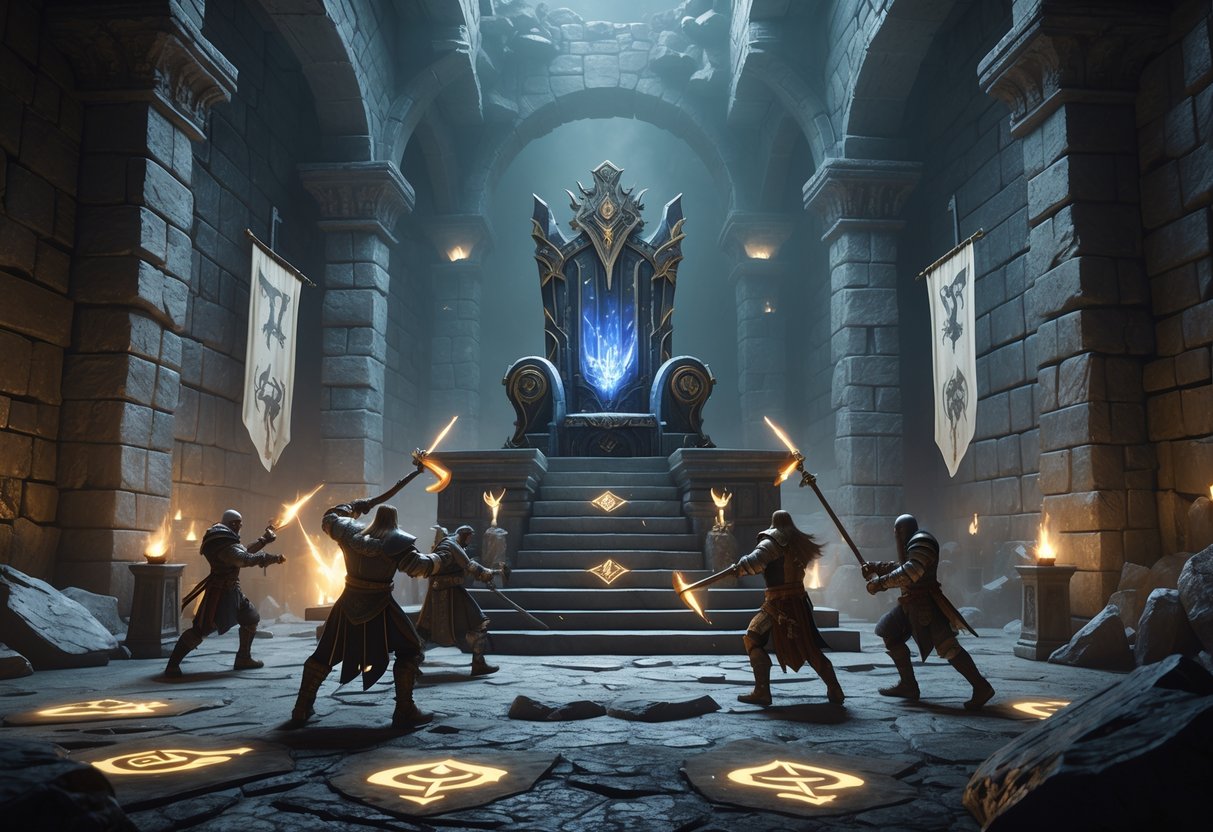
Throne and Liberty flips the script on regular dungeons by turning them into PvP battlegrounds at certain times. Once night falls, all open world dungeons become PvP zones where you have to fight both monsters and other players.
Dungeon-Specific Events
Open world dungeons automatically switch to PvP during nighttime. Night cycles last about 30 minutes in-game.
During these periods, anyone entering a dungeon can attack or be attacked. The monsters remain, but now you’ve got to watch your back for players too.
PvP-enabled dungeons offer:
- High risk, high reward gameplay
- Unique loot available only during PvP hours
- Encounters that mix monster fights with player battles
These events get competitive fast. Players form groups to clear the dungeon and fend off rivals.
The rotating schedule means different dungeons go PvP at different times. No single guild can lock down a dungeon forever.
PvP Conflict and Peace Tags
Players can decide how much PvP they want by choosing conflict tags. If you want to avoid fighting, just pick peace mode before heading in.
Peace tag limitations:
- Can’t attack other players
- Most players can’t attack you
- You might miss out on certain dungeon rewards
Conflict mode gives you access to all PvP rewards, but you’ll always be at risk from other players looking for loot.
If you’re new, try peace tags at first. Once you’re comfortable, switch to conflict for the bigger prizes and the rush of PvP.
The tag system lets everyone play dungeons at their own pace. You can change your tag before entering any PvP-enabled area.
Tournament Rewards and Prizes

Tournament rewards in Throne and Liberty range from huge Lucent pools—sometimes over a million—to rare titles and cosmetics. The biggest tournaments even offer real value through premium currency, while smaller events give out unique in-game items you can’t find anywhere else.
Lucent Prize Pools
The Blue Squadron Best in Guild Talandre Championship Series hands out a massive 1,300,000 Lucent prize pool. This tournament runs from late May through June and focuses on Conquest Battle matches.
Lucent is the game’s premium currency. You can spend it on cosmetics, convenience features, and other special stuff in the shop.
Big tournaments usually split prizes among winning teams, not just single players. Every team member gets a share.
Community-run tournaments offer smaller—but still worthwhile—Lucent rewards. These are more accessible for newer guilds and players.
Unique Titles and Cosmetics
PvP tournaments let players earn exclusive titles and cosmetics that you can’t get anywhere else. The Arena Pre-Season gave out special titles through inter-server matchmaking.
Morphs are some of the most wanted tournament rewards. These items change your character’s look and are prized by collectors.
Tournament-only Amitoi companions add both style and function. These pets help with gameplay and show off your PvP wins.
Outfits and weapon skins from tournaments have unique designs that make PvP players stand out. You can’t buy these with Lucent or earn them any other way.
In-Game Currencies and Drops
Arena competitions give out Arena Coins no matter where you place. You can trade these for PvP gear and upgrades.
Ornate Coins show up as rewards in certain tournaments. These unlock special items from particular vendors.
Some tournaments use Twitch drops during livestreams. Watch official streams and link your account for bonus rewards.
You’ll often get extra stuff like weapon specialization points and progression items just for joining in. These rewards help you grow your character, not just your wardrobe.
Platforms and Accessibility

Throne and Liberty works across multiple platforms and supports cross-server play. Players can join PvP tournaments from different systems and link accounts for a smoother experience.
Xbox and Cross-Platform Play
Xbox players get full access to Throne and Liberty PvP tournaments, right alongside PC users. The game uses cross-server matchmaking for Arena mode, so Xbox and PC players face off in the same pool.
This setup works especially well for 3v3 Arena tournaments. You’ll find matches fast, no matter your platform.
You need to reach level 50 to enter the Arena on Xbox, just like everywhere else. Queue solo or team up with friends—even if they’re on another system.
Xbox-specific benefits include:
- Controls optimized for PvP
- Xbox Live for friend invites
- Achievement tracking for tournament play
A lot of tournaments also offer Twitch drops during official streams. Xbox players can link their Twitch accounts and claim these rewards while watching the action.
Access and Account Linking
Account linking makes tournament access way smoother across all your devices. Honestly, it’s best to connect your Amazon Games account early—waiting until right before a big tournament just creates headaches.
You can link everything in just a few minutes. Head to the Amazon Games website, log in, and connect your platform accounts from the account management section.
Required steps for tournament access:
- Create an Amazon Games account
- Link your Xbox or Steam profile
- Verify your email address
- Complete character setup to level 50
Once you link your accounts, tournament rewards sync automatically. That includes Arena ranking points, seasonal rewards, and any Twitch drop items you’ve managed to claim.
If you skip account linking, you might miss out on cross-platform team play. It’s a bummer if you want to compete with friends who use different systems during tournaments.
Streaming and Community Engagement
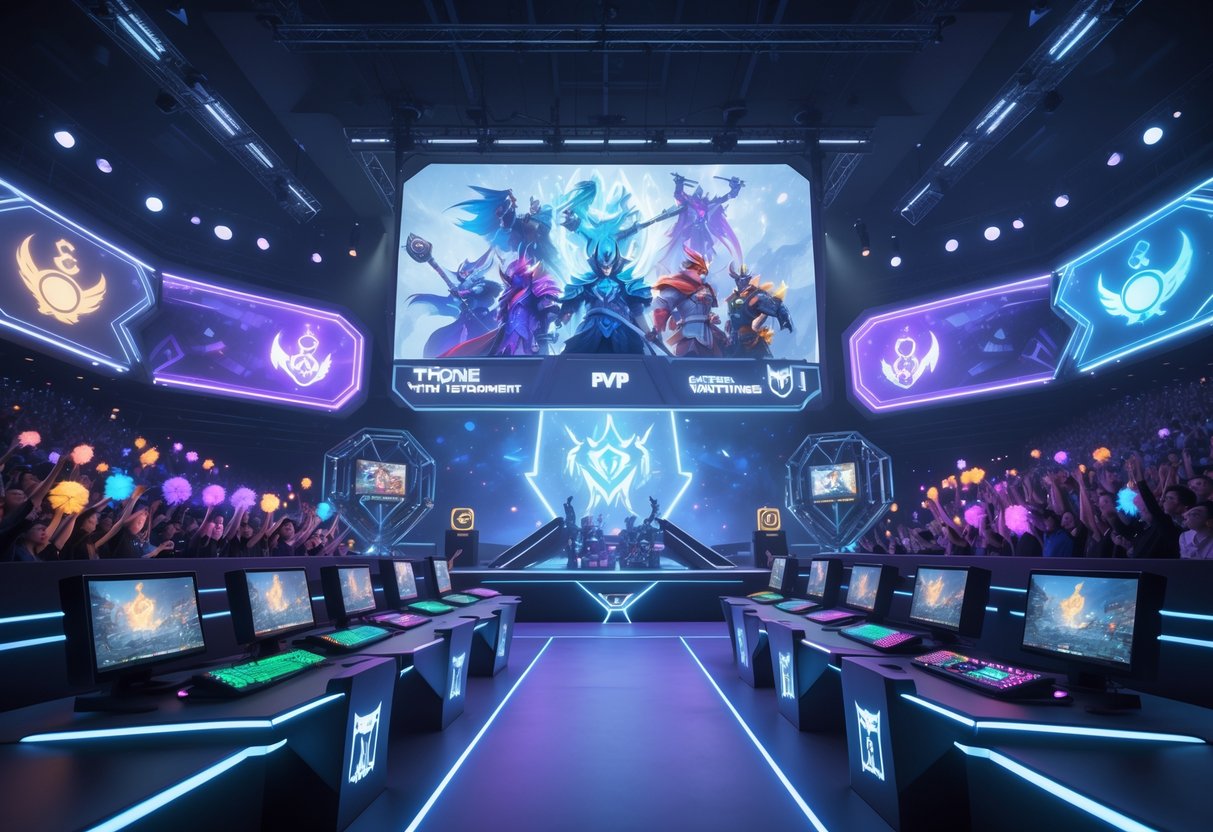
Throne and Liberty tournaments really come alive thanks to streaming partnerships and community broadcasts. These days, most major competitions use Twitch drops to reward viewers, while content creators build huge audiences around tournament streams.
Twitch Drops Integration
Tournament organisers regularly team up with Twitch to give out exclusive in-game rewards. You can get rare cosmetics, progression materials, and other limited goodies that you won’t find in the regular game.
The system’s automatic once you link your game account to Twitch. You just watch participating streams for a set amount of time, and rewards unlock as you go.
Common drop rewards include:
- Character cosmetics and weapon skins
- Amitoi companions and morphs
- XP boosts and crafting materials
- Exclusive titles and achievements
Usually, you need to watch for 2-4 hours to grab all available drops. The rewards show up in your in-game mail within a day—sometimes sooner, but patience helps.
Some events have tiered drops, so the longer you watch, the better the prizes. It definitely keeps viewers around for the whole broadcast instead of just popping in and out.
Official Tournament Broadcasts
Major Throne and Liberty tournaments bring in professional broadcast teams with veteran casters and analysts. These streams run on multiple platforms at once, so more people can tune in.
The EU Best in Guild tournament really showed how well this works. Over 50 guilds joined, so the event needed several days of coverage and a full team of commentators.
Broadcast features you’ll usually see:
- Live commentary from experienced players
- Real-time stats and guild info
- Multiple camera angles during battles
- Post-match analysis and interviews
Content creators like Blue Squadron have built big followings by hosting these tournaments. Their streams often pull in thousands of viewers who chat and react live.
A lot of tournaments now let smaller streamers co-stream the matches to their own audiences. It’s a great way to boost viewership and help new streamers get noticed.
Frequently Asked Questions

If you want to join a tournament, you’ll need to know the level requirements, team setups, and how rewards work. Most competitive events have their own rules about entry and scheduling that affect who can play.
What are the rules for participating in PvP tournaments in Throne and Liberty?
You need to reach level 50 before you can enter Arena tournaments. That’s the main requirement for competitive PvP.
The Arena uses a cross-server system. You might face opponents from any server.
There are three game types for tournaments. Individual matches pair you with random teammates, while team matches let you bring up to two friends.
Players who leave matches early get penalties. The system enforces good sportsmanship automatically.
How do the team-based dynamics work in Throne and Liberty’s tournament matches?
Arena tournaments always use a 3v3 format. Each team gets three players and fights another team of three.
Your team shows up highlighted in blue. The enemy team appears in red—super clear, thankfully.
Battle Token mechanics add a strategic layer to team play. Each player starts with two tokens, and if you take out an opponent, you steal their tokens for extra points.
Teams can coordinate which buffs to pick during matches. Three buffs spawn in the arena, and each player picks the one that fits their playstyle.
Is there an entry fee or minimum level requirement to join Throne and Liberty’s competitive events?
Level 50 is the only real requirement for Arena participation. There aren’t any entry fees for standard tournaments.
You can access the Arena from the main menu using Esc or F10. The game lets you solo queue or enter with a pre-made team.
Three match types give everyone options. You can play ranked or unranked, and friendly matches are there for practice.
Can players earn in-game rewards from winning PvP tournaments in Throne and Liberty, and if so, what might they be?
Special Arena tournament events hand out extra rewards. These events get more players involved in competitive PvP.
Some rewards come just for showing up and playing. Others depend on your performance and results.
Performance-based rewards tend to be better than simple participation rewards. The system motivates players to improve and aim for wins.
Event schedules change, but they pop up regularly throughout each competitive season. Keep an eye out for announcements about special tournaments with bigger prizes.
What are the most effective strategies for success in Throne and Liberty’s PvP competitive scene?
Teams earn points every 30 seconds based on kills and eliminations. Go for eliminations instead of just dealing damage if you want to maximize your score.
The first team to hit 200 points wins right away. That adds a lot of pressure to stay aggressive but not overextend.
Battle Token control is huge for extra points. Work with your teammates to secure kills and keep a token lead.
When picking buffs, choose ones that actually help your team composition. The right buffs can really boost your strategy.
How often are PvP tournaments held in Throne and Liberty, and where can one find the schedule?
You can jump into Arena matches pretty much whenever you want, thanks to the matchmaking system. Just queue up for either ranked or unranked games—there’s no set time.
Sometimes, the game hosts special tournament events with bigger rewards. The devs announce these events with in-game notifications, so you’ll want to keep an eye out.
PvP zones in the open world don’t always stay the same. The zones rotate on a daily schedule, and you’ll see which areas are PvP-enabled and when events kick off.
If you’re ever unsure, open the main menu and head to the Arena section. That’s where you’ll find up-to-date info on both regular matches and special events.


